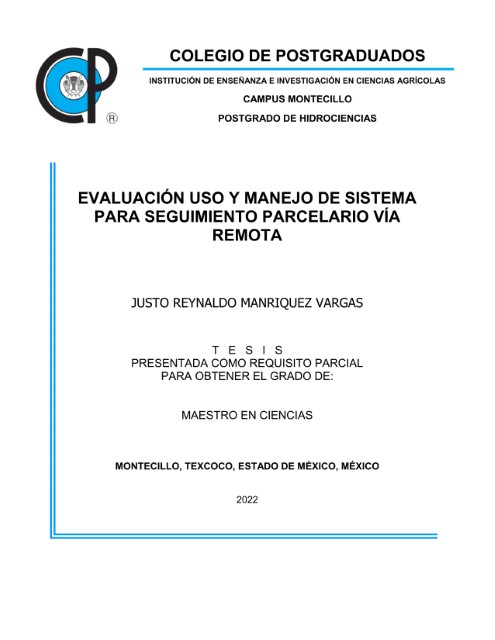
Fecha: 2022-06
JUSTO REYNALDO MANRIQUEZ VARGAS, M. C. Colegio de Postgraduados, 2022
RESUMEN
Desde su transferencia, los distritos de riego a nivel
nacional se han visto en escenarios que ponen a prueba su administración e
infraestructura, cada vez en mayor frecuencia y magnitud. El Distrito de Riego
030 Valsequillo, se encuentra entre los casos citados, presenta en mayor o menor
grado, reducción de áreas regadas y reducción en sus volúmenes de agua
disponibles. Una de las actividades que tiene asignada el distrito de riego es
la de cuantificar y reportar las áreas sembradas de manera anual (riego y
temporal), este valor es obtenido mediante tabulaciones, registro de usuarios y
registro de cobranzas por concepto de pago de aguas. Los resultados obtenidos no
pueden ser comparados con otra metodología, se consideró de utilidad el tener un
segundo valor obtenido teniendo como criterio el crecimiento de los cultivos y
la superficie parcelaria del distrito. Se realiza para el presente proyecto la
evaluación de imágenes satelitales en un periodo de 5 años (2016-2020), con el
objetivo de realizar la cuantificación de las áreas cultivadas en el Distrito de
Riego 030 Valsequillo, conocer las diferencias existentes entre las áreas
obtenidas y las áreas reportadas de manera oficial; finalmente explicar de
manera detallada y paso a paso la metodología necesaria con el fin de que el
personal encargado pueda generar sus propias cuantificaciones para los periodos
subsecuentes. Los materiales y métodos empleados para la estimación del área
cultivada fueron imágenes satelitales gratuitas de tipo Landsat 8, aprovechando
sus capas pancromáticas para obtener el índice de vegetación NDVI (Normalized
Difference Vegetation Index) uno de los indicadores más empleados como índice
vegetativo y que permite estimar los cambios que existen en la cubierta vegetal
a través del uso de imágenes satelitales. Teniendo en consideración este índice
se calcularon las áreas que se sembraron en el distrito durante los años
indicados. Los resultados que se esperan obtener consisten en que las áreas
obtenidas de manera satelital y las áreas reportadas por parte del distrito de
riego coincidan o se aproximen, de ser así significaría que la cuantificación es
correcta, en caso contrario reflejaría problemáticas en la zona del distrito de
riego 030 Valsequillo. Las actividades del presente proyecto forman parte de un
monitoreo recomendado para las zonas cuya superficie abarque una cantidad
importante de parcelas como lo es el Distrito de Riego 030 Valsequillo. Los
resultados obtenidos arrojaron de manera cuantitativa el diferencial entre los
volúmenes reportados y los calculados de manera remota.
Palabras clave: NDVI, Área cultivada, Landsat, Distrito de Riego 030 Valsequillo.
EVALUATION, USE AND MANAGEMENT SYSTEM FOR AGRICULTURAL PARCEL TRACKING USING REMOTE SENSING.
ABSTRACT
The irrigation districts in mexico have had problems whit their administration and infrastructure, this problem increase over time and repeats whit frequency and greater scale. Irrigation District 030 Valsequillo, have this issues, like reduction of irrigated areas and reduction in its volumes of available water. Once a year the irrigation district 030 Valsequillo need count and report the irrigated areas, this value is obtained through tabulations, user registration and registration for payment of water. The results obtained cannot be compared with another methodology, is necessary have a second point of view. This second opinion is obtained using remote sensing, crop developing and geographic information of the district. In this project, was use remote sensing, using satellite imagery and geospatial analysis techniques for 2016, 2017, 2018, 2019 and 2020, with the aim of quantifying the cultivated areas in the area corresponding to the Irrigation District 030 Valsequillo, knowing the differences between the areas obtained and the areas officially reported; In the final phase, has explained in detail and step by step the necessary methodology, this methodology allow field staff, senior planners and director repeat this project for future years. The materials and methods used to estimate the cultivated area used free satellite imagery (Landsat 8), apply geospatial analysis techniques to obtain NDVI (Normalized Difference Vegetation Index) vegetation index, it?s important to remember that NDVI quantifies vegetation by measuring the difference between near-infrared and red light, near-infrared represent vegetation strongly reflects and red light represent vegetation absorbs. The results that are expected to be obtained consist of the following points, All areas reported between 2016 ? 2020 will be compared to areas obtained by satellite imagery at the same time. If the agricultural area are the same or similar means that the irrigation district counts correctly the irrigation volume user?s otherwise means problems with the data, area or volume irrigation in irrigation district 030 Valsequillo. The activities of this project there are part of a recommended monitoring for agricultural areas in Irrigation District 030 Valsequillo, because have large working agricultural areas. The results, showed the difference between the areas reported and area calculated using satellite imagery.
Key words: NDVI, Cultivated area, Landsat, Irrigation District 030 Valsequillo.